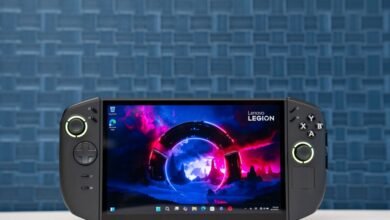Lenovo Legion Go S Review: Did It Live Up to the Hype?

▼ Summary
– The Lenovo Legion Go S with SteamOS is not a true Steam Deck competitor due to its higher price ($599 vs. $550) and tradeoffs, despite initial hype.
– SteamOS significantly improves performance and battery life on the Legion Go S compared to its Windows version, offering up to 30% faster framerates and extra gameplay time.
– The Legion Go S lacks key features of the Steam Deck, such as responsive touchpads, community controller layouts, and ergonomic design, limiting its usability.
– While the Legion Go S’s Z1 Extreme model offers better performance, the Steam Deck OLED remains superior for price, battery life, and ease of use in less demanding games.
– The article recommends waiting to buy a handheld PC due to upcoming improvements in Windows for handhelds and high current prices, despite SteamOS’s advantages.
The Lenovo Legion Go S promised to challenge the Steam Deck’s dominance in handheld gaming PCs, but does it deliver? Valve’s Steam Deck has set the gold standard since its 2022 launch, combining performance, usability, and affordability in a way competitors struggle to match. The Legion Go S, Lenovo’s SteamOS-powered alternative, generated buzz as the first authorized third-party device running Valve’s operating system. However, reality paints a more nuanced picture.
Priced at $599 for the base model, the Legion Go S with AMD’s Z2 Go chip falls short of the $550 Steam Deck OLED in several key areas. While the $829 Z1 Extreme version offers better performance, it comes at a steep premium. The good news? SteamOS transforms the experience compared to the Windows version, eliminating bloatware and improving efficiency.
Performance gains with SteamOS are notable. In testing, Cyberpunk 2077 ran 17% faster on the Legion Go S with SteamOS compared to Windows, while Assassin’s Creed Valhalla saw a 30% boost. Battery life also improves, where Windows drained the 55Wh battery in 1.5 hours, SteamOS extended playtime to 2.5 hours for the same game.
Yet, the Legion Go S stumbles in critical areas. Its single, finicky touchpad pales next to the Steam Deck’s dual trackpads, and the lack of community controller layouts makes navigating keyboard-heavy games frustrating. The hardware itself is solid, with an 8-inch IPS display that outshines the Steam Deck’s 7.4-inch screen, but it lacks OLED’s deep blacks and HDR.
Where the Legion Go S shines is raw power. The Z1 Extreme model delivers up to 72% higher framerates than the Steam Deck when plugged in, making demanding titles like Expedition 33 playable. However, unplugged performance is less impressive, with the Steam Deck often matching or surpassing the Z2 Go in efficiency.
Battery life remains a sticking point. While the Z1 Extreme only sips 1-3W more than the Z2 Go, the Steam Deck OLED still dominates in lighter games, lasting two hours longer in Balatro thanks to superior optimization.
Lenovo and Valve have addressed early bugs, fixing issues with power modes and display refresh rates. Yet, the Steam Deck OLED remains the better value for most users, offering superior controls, battery life, and a vast library of community profiles. The Legion Go S Z1 Extreme is a compelling option for power-hungry gamers near an outlet, but with Microsoft working on handheld Windows improvements, it might be wise to wait before committing.
For now, the Steam Deck’s balance of price, performance, and polish keeps it on top, proving that even with SteamOS, the Legion Go S isn’t quite the challenger it hoped to be.
(Source: The Verge)





